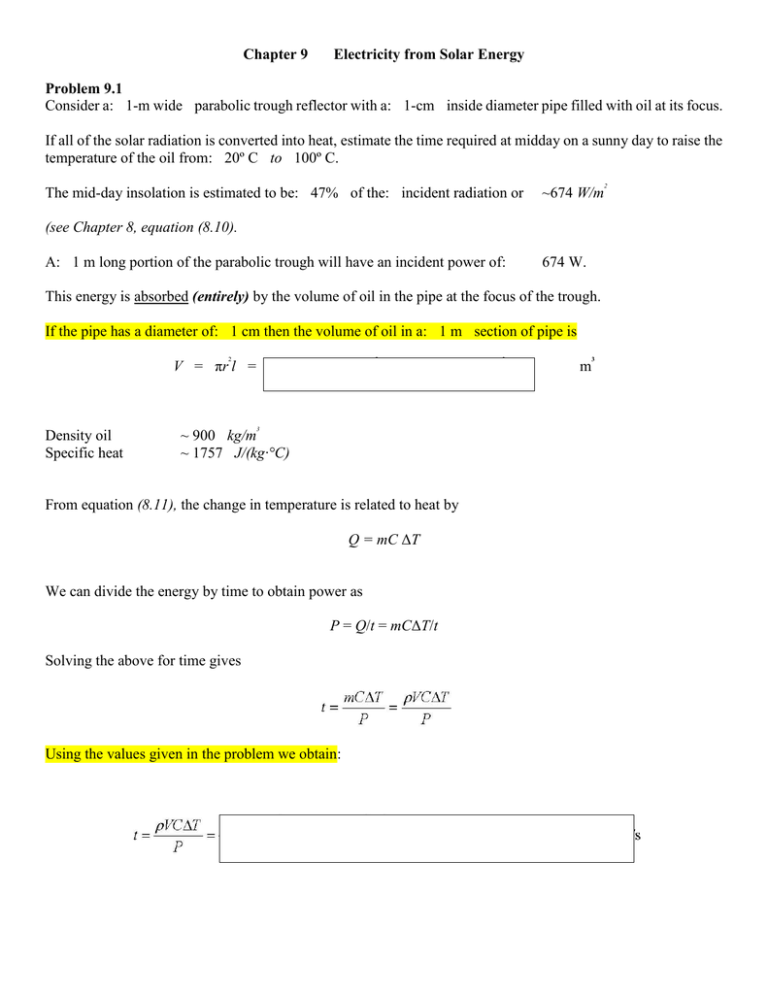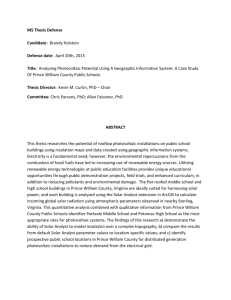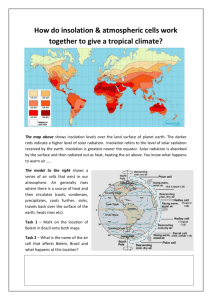Chapter 9 Electricity from Solar Energy Problem 9.1
advertisement

Chapter 9 Electricity from Solar Energy Problem 9.1 Consider a: 1-m wide parabolic trough reflector with a: 1-cm inside diameter pipe filled with oil at its focus. If all of the solar radiation is converted into heat, estimate the time required at midday on a sunny day to raise the temperature of the oil from: 20º C to 100º C. The mid-day insolation is estimated to be: 47% of the: incident radiation or 2 ~674 W/m (see Chapter 8, equation (8.10). A: 1 m long portion of the parabolic trough will have an incident power of: 674 W. This energy is absorbed (entirely) by the volume of oil in the pipe at the focus of the trough. If the pipe has a diameter of: 1 cm then the volume of oil in a: 1 m section of pipe is 2 2 V = πr l = (3.14) × (0.005 m) × (1 m) = 7.85 × 10 Density oil Specific heat 3 ~ 900 kg/m ~ 1757 J/(kg·°C) From equation (8.11), the change in temperature is related to heat by Q = mC ΔT We can divide the energy by time to obtain power as P = Q/t = mCΔT/t Solving the above for time gives Using the values given in the problem we obtain: –5 m 3 Problem 9.4 If all of the energy for humanity is generated using horizontal solar photovoltaic arrays with an efficiency of: 15% and which occupy: 1% of the land area of the earth, what is the maximum population density that can be supported? Assume that the world’s average per-capita energy use is the same as at present. 10 The average energy consumption per person (worldwide) is: 8.1 × 10 J per year. The average insolation (for all locations and all times) is given in Chapter 8 as: 168 W/m . Total land area on earth is: 8 2 1.49 × 10 km 14 2 2 or 1.49 × 10 m . A. Thus the total insolation on all of the earth's land area is: 2 14 2 (168 W/m ) × (1.49 × 10 m ) = 2.5 × 10 16 W. This assumes that the land masses are uniformly distributed in latitude. This in not exactly true but this assumption provides a good estimate of the actual situation. B. If 1% of the land area is used at an efficiency of: 15% then the total power available is: 16 (2.5 × 10 W) × (0.01) × (0.15) = 3.75 × 10 13 W C. Per year this amounts to a total annual energy of: 13 7 (3.75 × 10 W) × (3.15 × 10 s/y) = 1.18 × 10 21 J/y. D. Dividing by the energy requirement per person gives the maximum population that can be supplied 21 10 (1.18 × 10 J/y)/(8.1 × 10 J/(person y)) = 1.45 × 10 10 people This is more than twice the current world population and is greater than most estimates of what is sustainable. Problem 9.5 Estimate the diameter of a mirror array associated with a solar power tower, as illustrated in Figure 9.4, that would replace a: 1-GWe coal-fired generating station. Be sure to consider the method by which electricity is generated, as illustrated in Figure 9.6. Based on the information in Figure 9.6, the temperatures of the hot and cold reservoirs are Th = 1050°F = 565°C = 839 K Tc = 554°F = 295°C = 563 K and This gives an ideal Carnot efficiency of: 100 × Thus the total solar insolation must be: (1 – 563K/839K) = 1 GWe / 0.33 33 % = 3 GW. The installation in Figure 9.4 is in California and from Figure 8.2 the average insolation can be estimated to be: 2 225 W/m . The area needed to produce the necessary power is: 9 2 (3 × 10 W) / (225 W/m ) = 7 1.3 × 10 m 2 For a circular array this corresponds to an area about 4 km in diameter. Mirrors need to be tilted from the vertical (and adjusted during the day) to focus the incident sunlight on the receiver. For distances that are farther from the tower the mirrors will need to be closer to the vertical to direct the light to the receiver. This means that as the distance from the receiver increases then the distance between the rows of mirrors also has to increase in order to avoid shadowing effects. When the distance between the mirrors increases, the effective area that they cover decreases. Thus, as the diameter of the array increases the fraction of the insolation that is directed to the receiver decreases. This means that the area calculated in this problem is an under estimate and that there is a limit for the diameter of the array above which the geometry of the design is impractical. Problem 9.6 What is the maximum wavelength of light (in nanometers) that would produce an output from a photovoltaic device manufactured from a semiconductor with an energy gap of: 1.02 eV? From equation (9.4) E = 1240 / λ Energy is in: eV and wavelength is in: nm. Solving for wavelength: λ = 1240/E = (1240 nm/eV)/(1.02 eV) = 1216 nm Problem 9.7 What is the maximum wavelength of the light that produces voltage in a: CdS photovoltaic device? From equation (9.3) E = hc / λ or λ = hc / E Planck's constant as: h = 4.136 × 10 Speed of light as c = 3 × 10 Energy gap of CdS from Table 9.1 as E = 2.42 eV 8 –15 m/s, eV·s, Problem 9.8 Consider a typical family vehicle powered by photovoltaics similar to the vehicle shown in Figure 9.27 where the top surface is covered with 20% efficient cells. Compare the power available in such a vehicle on a sunny day in comparison with a typical gasoline-powered vehicle. Some typical vehicle characteristics are given in Table 19.3. Dimensions of a typical family vehicle (e.g. Toyota Camry) are: 4.81 m long by: 1.82 m wide. 2 This gives an area of: m. 0.47 is the fraction of sunlight transmitted through the atmosphere. On a sunny day the insolation on a horizontal surface at: 40° N latitude is given from equation (8.1) to be about: 2 (1434 W/m ) × (0.47) × (cos 40°) = 516 W/m 2 The total power available over the area of the vehicle from: 20% efficient solar cells is: 2 2 (8.75 m ) × (516 W/m ) × (0.20) = 900 W. This value can be compared with the power available for a typical gasoline powered family vehicle (see Table 19.3) which is about: 200 kW or 220 times that for the solar vehicle. This indicates the reason why direct solar powered passenger vehicles are not practical.






